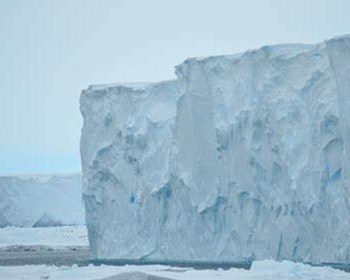(单词翻译:单击)
Throughout all this the tubeworms and clams and other life forms adhering to deep ocean vents undoubtedly went on as if nothing were amiss, but all other life on Earth probably came as close as it ever has to checking out entirely. It was all a long time ago and at this stage we just don't know.
这一时期,多毛虫、蛤蜊,以及其他附着于深海喷气孔的生命无疑继续存在,仿佛什么事儿也没有。而地球上所有其他生命很可能到了完全灭绝的边缘。这一时期距我们今天十分遥远,而我们目前对它的了解是极其匮乏的。
Compared with a Cryogenian outburst, the ice ages of more recent times seem pretty small scale, but of course they were immensely grand by the standards of anything to be found on Earth today. The Wisconsian ice sheet, which covered much of Europe and North America, was two miles thick in places and marched forward at a rate of about four hundred feet a year. What a thing it must have been to behold. Even at their leading edge, the ice sheets could be nearly half a mile thick. Imagine standing at the base of a wall of ice two thousand feet high. Behind this edge, over an area measuring in the millions of square miles, would be nothing but more ice, with only a few of the tallest mountain summits poking through. Whole continents sagged under the weight of so much ice and even now, twelve thousand years after the glaciers' withdrawal, are still rising back into place. The ice sheets didn't just dribble out boulders and long lines of gravelly moraines, but dumped entire landmasses—Long Island and Cape Cod and Nantucket, among others—as they slowly swept along. It's little wonder that geologists before Agassiz had trouble grasping their monumental capacity to rework landscapes.
与覆冰纪大爆发时代相比,最近几次冰川期的规模似乎要小得多,但以今天地球上的任何标准来衡量,它还是极其巨大的。覆盖欧洲和北美洲的威斯康星冰盖在某些地方厚达3公里,并且还以每年120米的速度不断前进。即使在其边缘地段,冰盖也差不多有800米厚。这是—个多么壮观的景象啊!想像一下,你站在一堵那么高的冰墙脚下,墙的后面是几百万平方公里的地方,除了几座刺向青天的冰峰,全都是一望无际的冰盖。整块整块的陆地在巨大的冰盖的压力下沉降,即使在荆”退却12000年后的今天,这些陆地还没有上升到原来的位置。在冰盖缓慢移动的过程中,不仅使巨大的石块和冰碛石堆改变了位置,而且还扔下整块整块的陆地——诸如长岛、科德角、楠塔基特岛等等。阿加西斯以前的地质学家难以,理解冰盖所具有的足以使地球表面发生变化的巨大的威力,这是不足为怪的。

If ice sheets advanced again, we have nothing in our armory that could deflect them. In 1964, at Prince William Sound in Alaska, one of the largest glacial fields in North America was hit by the strongest earthquake ever recorded on the continent. It measured 9.2 on the Richter scale. Along the fault line, the land rose by as much as twenty feet. The quake was so violent, in fact, that it made water slosh out of pools in Texas. And what effect did this unparalleled outburst have on the glaciers of Prince William Sound? None at all. They just soaked it up and kept on moving.
如果冰盖卷土重来,我们没有任何武器可以改变它们的方向。1964年,在阿拉斯加威廉王子湾,北美最大的冰川地区发生该大陆有记录以来最强烈的地震,其强度达里氏9.2级。在发生断层韵地方,地表上升了6米,这次地震是如此的强烈,连德克萨斯州的池塘水都溅到了岸上。但是,这次前所谓有的震动对于威廉王子湾的冰川产生了怎么样的影响呢?根本没有,冰川抵消了地震,继续其前进的步伐。


